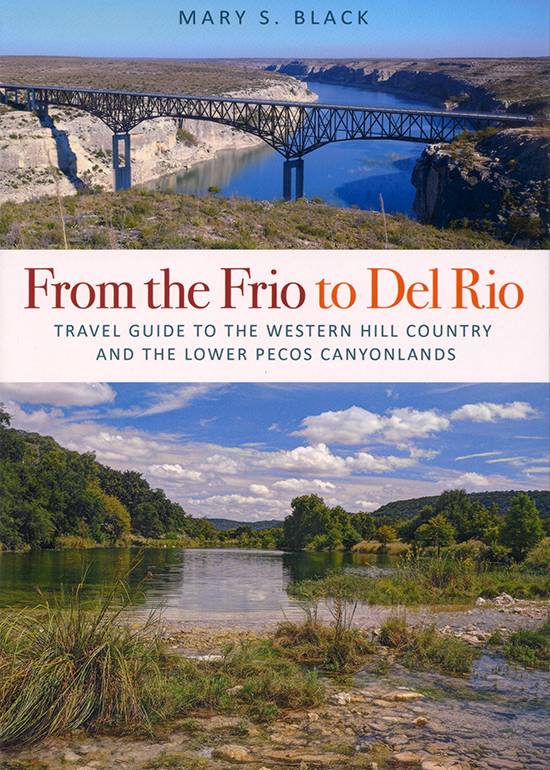Pack Your Bags

From the Frio to Del Rio: Travel Guide to the Western Hill Country and the Lower Pecos Canyonlands
by Mary S. Black
College Station: Texas A&M University Press, 2017.
210 pp. $21.99 paper.
Reviewed by
Noel Fuller
In the age of Google where researching destinations and planning trips often begin with the click of a mouse, some might wonder what relevance a travel guide can possess. However, as found with Mary S. Black’s From the Frio to Del Rio, a travel guide with this level of expertise can offer prospective travelers a level of insight that makes the investment well worth a reader’s time.
The book starts with a brief overview for those unfamiliar with Southwest Texas. In addition to in-depth descriptions of the various subsections of the region, Black provides appropriate mappings and images to highlight places of interest. From picturesque canyons to historical forts, we glimpse multiple opportunities that avid travelers can expect as they embark on their journey. Readers are also treated to general recommendations ranging from packing suggestions to opportune weather in which to plan a trip.
As the book progresses, Black provides sectional breakdowns of the various locations. The natural environment features are covered first, and references to each landform are accented with “pro tips” in order to give the traveler an optimal experience. While the practical information about size and relative location are useful, the intriguing part of the read comes from the historical information. The history of certain rivers’ names, such as the Sabinal and Frio, are revealed as well as brief histories of the explorers who first traversed the region. Learning about the various battles and explorations provides further significance in addition to the natural mystique of the Lower Pecos.
An overview of the various state parks and recreation areas follows, and travelers are encouraged to strap on their hiking boots. The various sites have their information listed including addresses, websites, and hours of operation. Rates and fees for various camping excursions are provided to help travelers get a sense of the overall costs. A larger section is devoted to Garner State Park, one of the highlighted points of interest initially mentioned in the book. The author delves deep into the specific attractions of this park. A breakdown of hiking routes based on distance, level of difficulty, and general description is also provided. Particular care is given to mentioning the specific tours and guide recommendations for each destination. For example, Black provides details on multiple cave tours and excursions for Kickapoo Cavern State Park. With these types of recommendations, travelers have the necessary details to discern whether a particular park will appease their exploration desires.
My favorite section is the one that covers the viewable rock art. While this section is smaller than some of the others, Black gives an excellent breakdown of the subsets of rock art, including the stylistic regional differences in pictographs and petroglyphs. Furthermore, specific locations are given to let travelers know where they need to go in order to satisfy their artistic itch. Another section provides detailed descriptions of the various ghost towns. From Carta Valley to Pumpville, the book gives careful guidance for each individual history of these quiet little towns that dot the lower Pecos. These towns (with populations generally below twenty) make for interesting sight-seeing—but also come with cautions ranging from avoidance of trespassing to reminders to be on the lookout for hunters.
Another part gives an assorted list of restaurants and shops one might encounter on a trip. Each restaurant comes with a personal suggestion by Black as to what the top-dining choice is, and in some cases, highlights from secret menu items. Additional suggestions on scenic routes and historic spots are given with further justification for the adding them to what has likely become a jam packed itinerary.
My sole criticism to this effort lies in whether the carefully selected information, ranging from websites to specific prices for services, can hold up long enough for the book to remain a relevant and current source of information. As much as one can appreciate the intimate and comprehensive view of this region, it’s hard to foresee the casual traveler opting for this particular traveling companion. However, for those wanting historical context and recommendations based on personal experience, this work will be a valuable piece of literature opposed to the meticulous combing of digital resources.
Noel Fuller recently received his Masters of Science in interdisciplinary studies at Texas State University. His areas of emphasis included counseling, leadership, and corporate communication training and development. Originally from Portland, Texas, he has lived and worked in the San Marcos area since 2008. He currently serves as an Academic Advisor for the College of Education. Additionally, Noel has given several well-received presentations on advisor communication at the regional and national levels.
